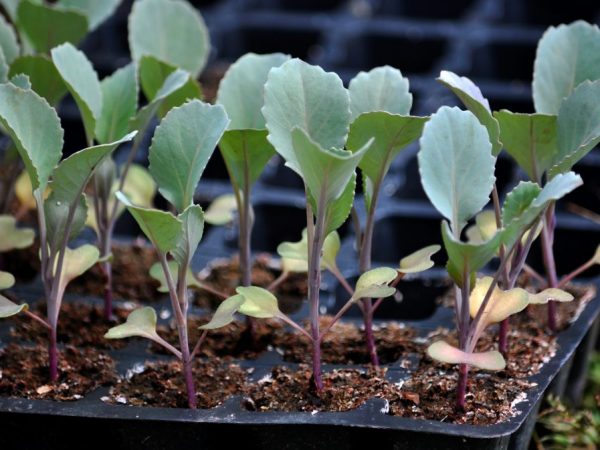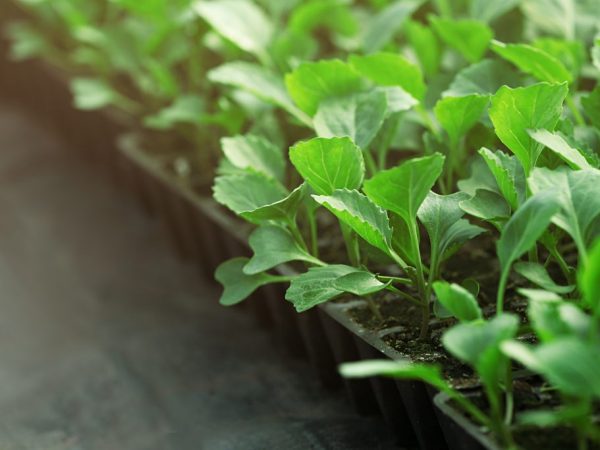Planting late cabbage for seedlings
Late varieties of cabbage are a valuable vegetable crop that does not accumulate nitrates during storage of the product. Planting of late cabbage for seedlings is done in spring, usually in early May.

Planting late cabbage for seedlings
Characteristics of varieties of late cabbage
Late varieties of cabbage are resistant to autumn frosts. They are often used for long storage and salting. A late variety of vegetables is undemanding to the type of land. It is well accepted during planting in open ground, if planted in beds after early crops: cucumbers, potatoes.
The most common varieties of late cabbage that are profitable to plant in different regions are:
- Aggressor. A hybrid species that does not require much maintenance. The average weight of 1 head of cabbage is 3-5 kg. There is immunity to thrips, fusarium wilting and punctate necrosis. Sowing is carried out in early May.
- Mara. The growing season is 165 days. The heads weigh 3-4 kg. This variety is distinguished by high taste, suitable for fermentation or fresh consumption.
- Amager. Cold-resistant species that does not tolerate heat. Cabbage heads weigh up to 6 kg. The yield is from 5 to 7 to 1 sq. m. Long-distance transportation is possible. Ripening period - 120 days.
Terms and stages of preparation
Late cabbage is most often grown in greenhouses or at home. Planting of late cabbage for seedlings occurs in mid-March. The dates for planting it in open ground fall in April. The seeds are prepared 14 days before growing the seedlings to achieve a healthy and bountiful harvest.
The main stages of the preparation of seeds of late varieties:
- Calibration. It is used to select low-quality seeds. They are soaked in a 3% soda solution. Those that have surfaced are not suitable for sowing.
- Germination rate. The seeds are checked for the ability to start and rise, so they are placed on a damp cloth, covered with glass and placed in a warm room.
- Disinfection. For prevention, the seeds are dipped in a manganese solution. To do this, mix 10 g of potassium manganese and 0.5 l of water. They need to be kept for 10 minutes, and then rinsed thoroughly.
- Soak. Before sowing, the seeds are immersed in 20 ° C water for 17 hours.
- Hardening. It is designed to increase the plant's resistance to weather extremes. The dried seeds are placed in a refrigerator for 24 hours at a temperature of 2 ° C.
Cabbage is diving. Any container for seedlings is chosen: boxes, pots. However, they should not be located in a draft after sowing. Cold, strong winds make the plant weak and vulnerable to disease.
For disinfection and prophylaxis, it is also recommended to use solutions that can be purchased at the store: Baktofit, Baikal M1, Albit, Maxim, Fitosporin-M.
At home, for disinfection, cabbage seeds are immersed in hot water with a temperature of up to 45 ° C in a cloth bag.To keep the high temperature in the container with water longer, the plant is placed in a bowl with a temperature 10-15 ° C higher or in a device for heating water with a specially set temperature. Also, cleaning is carried out by putting the seeds in a multicooker in the Yogurt mode.
Sowing seeds for seedlings

Not at all difficult to leave
After hardening, the seeds are sown into the soil from sand, peat and turf. Before cultivation, the soil is prepared and disinfected. This can be done with a potassium permanganate solution.
Sow cabbage in narrow rows 10-15 mm deep according to the scheme: 1 cm between the holes and 3-4 cm between the furrows, 3-4 seeds each. For rapid growth, the plant needs an appropriate temperature regime. During the day - about 15-30 ° C, in the evening the minimum temperature is 9 ° C.
It is necessary to pay attention to soil moisture. It should not be dry and waterlogged, as the cabbage can get sick. Seeds of late varieties germinate within a week, and after 14 days a pick is made.
Transplanting seedlings into open ground
Planting a late variety bush in open ground is carried out in early May, when the seedling has formed a root system. It is recommended to perform the procedure in the evening or in cloudy weather, in a row or staggered. 2 weeks before transplanting in greenhouses, they begin to open windows and doors for a couple of hours so that the seedling gradually gets used to the environmental conditions in the garden.
It is necessary to transplant the plant into the garden when there are already more than 5 leaves on it. Transplanting scheme: 70 cm between bushes and 60 cm between rows. It is not recommended to plant cabbage in places where it previously grew:
- beet;
- radish;
- tomatoes.
This leads to the sterility of the plant. Carrots, legumes, or grains are considered good precursors.
Watering
A late variety of vegetable crops is watered 2 times a week immediately after planting in open ground. In early and mid-August, the plant needs abundant watering, since heads of cabbage are laid at this time.
Watering the bushes costs about 8 liters per 1 m². At the end of summer, this is done once a week. After watering, the soil is loosened 7 cm deep.
Hilling
Hilling improves the development of the vegetable, helps to avoid fruit rotting. The bush is huddled only after the plant has strengthened in a permanent place and has begun to grow. The procedure is performed every 10 days, about 2 weeks after transplanting the seedlings to a permanent place in the garden. You can also fertilize the bush with a mullein mixture.
The soil under the vegetable crop should be loosened and covered with wood ash: 1 tbsp. on 1 m² of land. Hilling is carried out on a windless day. Before this action, for 3 days, the plants are fertilized with 10-15% chicken droppings.
Fertilizers for seedlings
When the first leaves appear on the plant, it is treated with a solution with trace elements. To do this, take 1 liter of water and mix with 7-10 g of complex trace elements.
Fertilizers that can be used for seedlings and seeds of late cabbage:
- Ash and soap solution. To do this, 1 kg of ash is infused for 48 hours in 8 liters of boiling water, then filtered and a bucket of water with 40 g of instant soap is added. Spraying with such a mixture is carried out 1-2 times a month.
- Before hardening, the leaves are sprayed with a sulfate mixture. To prepare this solution, you will need 1 tbsp. l. potassium sulfate, 1 tbsp. l. urea diluted in 10 liters of water. A seedling bush needs 300-400 ml of solution.
- Nitrophoska solution for seeds. Take 5 g of a trace element and dissolve in 450 ml of water. They hold for 10-11 hours.
Growing late cabbage gives the best yields next to tomatoes, mint and dill bushes. They release phytoncides, which are repellants for many dangerous insect pests.
Seedling diseases
Common ailments for late varieties are black leg and phomosis.
Blackleg is a fungal disease of the stem that leads to decay and death of the vegetable. The main cause of infection is acidic soil with a low dose of trace elements. It is characterized by yellow leaves and a dark stem.Diseased plants cannot be cured, therefore they are destroyed, and the remaining healthy bushes are treated with a solution of potassium permanganate (0.5 g per 1 liter of water).
Phomosis is a bacterial disease that occurs due to untreated planting material. Signs of the disease are black spots on the leaves and stems. Such vegetables are not treated, they are removed.
Conclusion
Planting dates and proper care ensure a good harvest of the late variety. To get healthy and weather-resistant seedlings of late varieties, a set of necessary measures is taken.


